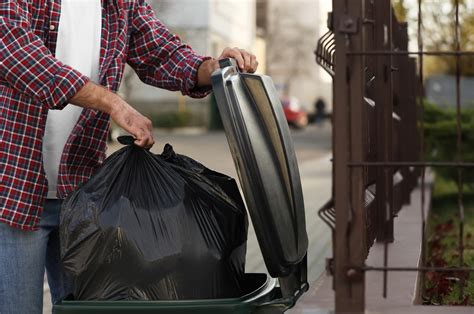Introduction
Maintaining a clean and hygienic living environment is crucial for both physical and mental well-being. Taking out the garbage regularly is an essential household chore that contributes significantly to this goal. However, the frequency with which garbage should be removed varies depending on several factors, including the size of the household, the type of garbage generated, and the local climate. This article provides a comprehensive guide to help you determine the optimal garbage removal frequency for your specific situation.

Factors Influencing Garbage Removal Frequency
Household Size and Composition
The number of people living in a household directly impacts the volume of garbage generated. Larger households produce more waste, necessitating more frequent garbage removal. Additionally, the composition of the household—for instance, the presence of infants or pets—can also affect garbage production rates.
Type of Garbage Generated
Different types of garbage decompose at varying rates. Organic waste, such as food scraps and yard trimmings, decomposes rapidly, creating unpleasant odors and attracting pests. Conversely, inorganic waste, such as plastics and metals, takes much longer to break down.
Local Climate
Climate plays a significant role in garbage removal frequency. In warmer climates, garbage decomposes more quickly, requiring more frequent removal to prevent foul odors and health hazards. In colder climates, garbage decomposes at a slower pace, allowing for less frequent removal.
Recommended Garbage Removal Frequencies
Based on the aforementioned factors, here are some general guidelines for garbage removal frequency:
Small Households (1-2 People)
- Organic waste: Weekly
- Inorganic waste: Biweekly
Medium Households (3-4 People)
- Organic waste: Twice weekly
- Inorganic waste: Weekly
Large Households (5+ People)
- Organic waste: Daily or every other day
- Inorganic waste: Weekly
Households with Infants or Pets
- Organic waste: Daily
- Inorganic waste: Twice weekly
Benefits of Regular Garbage Removal
- Eliminates odors and pests: Taking out the garbage regularly prevents unpleasant odors from accumulating and attracting pests, such as flies, cockroaches, and rodents.
- Prevents health hazards: Organic waste can harbor harmful bacteria and pathogens that can pose health risks to humans and pets. Removing garbage regularly minimizes the risk of exposure to these microorganisms.
- Environmental protection: Landfills are the primary destination for household waste. Overfilling landfills contributes to environmental pollution and the depletion of natural resources. Regular garbage removal helps reduce the amount of waste sent to landfills.
Pain Points and Motivations
Pain Points
- Foul odors
- Pest infestation
- Health concerns
- Environmental impact
Motivations
- Maintaining a clean and healthy home
- Preventing discomfort and health risks
- Reducing environmental pollution
- Complying with local regulations
Effective Strategies
- Use smaller garbage cans: Smaller cans fill up more quickly, necessitating more frequent removal.
- Compost organic waste: Composting breaks down organic waste naturally, reducing the amount of garbage generated.
- Recycle and reuse: Recycling and reusing materials reduces the amount of waste sent to landfills.
- Dispose of hazardous waste properly: Hazardous waste, such as batteries and electronics, should be disposed of at designated facilities to prevent environmental contamination.
Table 1: Garbage Removal Frequency Based on Household Size
| Household Size | Organic Waste | Inorganic Waste |
|---|---|---|
| 1-2 People | Weekly | Biweekly |
| 3-4 People | Twice weekly | Weekly |
| 5+ People | Daily or every other day | Weekly |
Table 2: Garbage Removal Frequency Based on Type of Waste
| Type of Waste | Decomposition Rate | Recommended Removal Frequency |
|---|---|---|
| Organic waste (food scraps, yard trimmings) | Rapid | Daily or every other day |
| Inorganic waste (plastics, metals) | Slow | Weekly |
| Hazardous waste (batteries, electronics) | N/A | Dispose of at designated facilities |
Table 3: Garbage Removal Frequency Based on Local Climate
| Climate | Garbage Decomposition Rate | Recommended Removal Frequency |
|---|---|---|
| Warm | Rapid | More frequent removal |
| Cold | Slow | Less frequent removal |
Table 4: Pros and Cons of Different Garbage Removal Frequencies
| Frequency | Pros | Cons |
|---|---|---|
| Daily | Eliminates odors and pests | May be inconvenient |
| Weekly | Less frequent than daily | May lead to unpleasant odors |
| Biweekly | Minimizes garbage accumulation | May attract pests if organic waste is not disposed of properly |
Conclusion
Taking out the garbage regularly is a crucial household chore that contributes to a clean and healthy living environment. The optimal garbage removal frequency varies based on factors such as household size, type of waste generated, and local climate. By understanding these factors and following the guidelines provided in this article, you can determine the best garbage removal schedule for your specific situation. Remember that regular garbage removal not only eliminates unpleasant odors and pests but also protects your health and the environment.
